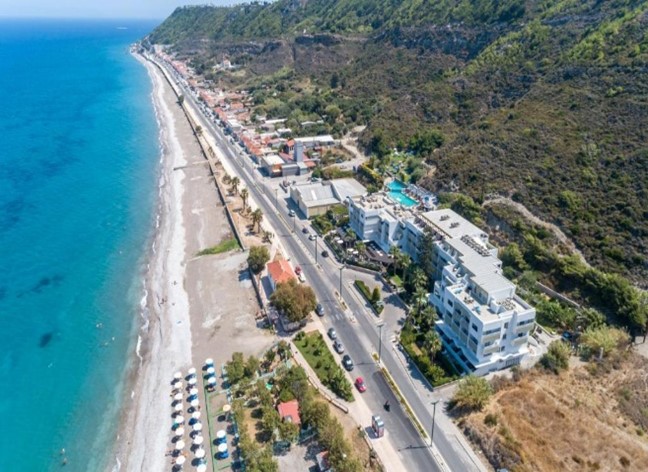| 1 |
Applied Signal Processing Systems |
|
1.1: |
Algorithm and architecture design and synthesis |
|
1.2: |
Signal processing hardware |
|
1.3: |
Signal processing software |
|
1.4: |
Signal processing systems |
|
1.5: |
Signal processing over IoT |
|
1.6: |
Emerging topics in signal processing systems |
|
|
|
|
|
|
| 2 |
Audio and Acoustic Signal Processing |
|
2.1: |
Modeling, analysis and synthesis of acoustic environments |
|
2.2: |
Detection and classification of acoustic scenes and events |
|
2.3: |
Auditory modeling and hearing instruments |
|
2.4: |
Acoustic sensor array processing |
|
2.5: |
Active noise control, echo reduction and feedback reduction |
|
2.6: |
System identification and reverberation reduction |
|
2.7: |
Audio and speech source separation |
|
2.8: |
Audio signal enhancement and restoration |
|
2.9: |
Audio and speech quality and intelligibility measures |
|
2.10: |
Spatial audio recording and reproduction |
|
2.11: |
Audio and speech modeling, coding and transmission |
|
2.12: |
Music signal analysis, processing and synthesis |
|
2.13: |
Music information retrieval and music language processing |
|
2.14: |
Audio for multimedia and audio processing systems |
|
2.15: |
Bioacoustics and medical acoustics |
|
2.16: |
Audio security |
|
|
|
|
|
|
| 3 |
Biomedical Imaging and Signal Processing |
|
3.1: |
Medical image reconstruction and restoration |
|
3.2: |
Medical image detection and estimation |
|
3.3: |
Medical image registration and motion analysis |
|
3.4: |
Medical image feature extraction and fusion |
|
3.5: |
Biological image analysis |
|
3.6: |
Physiological signal processing (ECG, EEG, MEG) |
|
3.7: |
Brain/human-computer interfaces |
|
3.8: |
Bioinformatics |
|
|
|
|
|
|
| 4 |
Computational Imaging |
|
4.1: |
Computational imaging methods and models |
|
4.2: |
Compressed sensing |
|
4.3: |
Learning-based computational imaging models |
|
4.4: |
Computational image formation |
|
4.5: |
Computational imaging systems |
|
4.6: |
Computational photography |
|
|
|
|
|
|
| 5 |
Image, Video, and Multidimensional Signal Processing |
|
5.1: |
Image and video sensing and acquisition |
|
5.2: |
Image and video representation |
|
5.3: |
Perception and quality models for images and video |
|
5.4: |
Signal processing for images and video modeling |
|
5.5: |
Biomedical and biological image processing |
|
5.6: |
Image and video coding |
|
5.7: |
Imaging and video networks |
|
5.8: |
Image and video processing for watermarking and security |
|
5.9: |
Multimedia communications |
|
5.10: |
Scanned, color, and multispectral imaging and processing |
|
5.11: |
Stereoscopic and multiview processing, display and coding |
|
5.12: |
Hardware and software systems for image and video processing |
|
5.13: |
3D image and video processing and analysis |
|
5.14: |
Image and video processing augmented and virtual reality |
|
5.15: |
Image and video content analysis |
|
5.16: |
Image and video storage and retrieval |
|
5.17: |
Machine learning for image processing |
|
5.18: |
Image and video synthesis, rendering, and visualization |
|
|
|
|
|
|
| 6 |
Information Forensics and Security |
|
6.1: |
Watermarking and data hiding |
|
6.2: |
Biometrics |
|
6.3: |
Communication and information theoretic security |
|
6.4: |
Multimedia forensics |
|
6.5: |
Multimedia content hash |
|
6.6: |
Adversarial machine learning |
|
6.7: |
Applied cryptography |
|
6.8: |
Anonymization and data privacy |
|
6.9: |
Cybersecurity |
|
6.10: |
Hardware security |
|
6.11: |
Network security |
|
6.12: |
System security |
|
6.13: |
Surveillance |
|
6.14: |
Usability and human factors |
|
6.15: |
Other forensics and security-related topics |
|
|
|
|
|
|
| 7 |
Machine Learning for Signal Processing |
|
7.1: |
Deep learning techniques |
|
7.2: |
Deep generative models |
|
7.3: |
Self-supervised and semi-supervised learning |
|
7.4: |
Transfer learning |
|
7.5: |
Adversarial machine learning |
|
7.6: |
Distributed/Federated learning |
|
7.7: |
Graph neural networks |
|
7.8: |
Reinforcement learning |
|
7.9: |
Learning theory and algorithms |
|
7.10: |
Bounds on performance |
|
7.11: |
Graphical and kernel methods |
|
7.12: |
Matrix factorizations/completion |
|
7.13: |
Dictionary learning |
|
7.14: |
Source separation |
|
7.15: |
Independent component analysis |
|
7.16: |
Sparsity-aware processing |
|
7.17: |
Subspace and manifold learning |
|
7.18: |
Tensor-based signal processing |
|
7.19: |
Cognitive information processing |
|
7.20: |
Information-theoretic learning |
|
7.21: |
Pattern recognition and classification |
|
7.22: |
Feature extraction/selection/learning |
|
7.23: |
Applications of machine learning |
|
7.24: |
Applications in music and audio processing |
|
7.25: |
Applications in time series analysis |
|
7.26: |
Learning from multimodal data |
|
7.27: |
Sequential learning; sequential decision methods |
|
7.28: |
Machine learning over wireless networks |
|
7.29: |
Big data |
|
|
|
|
|
|
| 8 |
Multimedia Signal Processing |
|
8.1: |
Multi-modal signal processing and analysis (audio/visual/haptics/radar/lidar etc.) |
|
8.2: |
Multimedia analysis and synthesis |
|
8.3: |
Multimedia compression, coding, conversion, and transcoding |
|
8.4: |
Multimedia standardization |
|
8.5: |
Human-centric multimedia and human-machine interaction |
|
8.6: |
Immersive multimedia technologies and applications |
|
8.7: |
Quality of experience |
|
8.8: |
Multimedia databases and information retrieval |
|
8.9: |
Multimedia communications and streaming |
|
8.10: |
Distributed multimedia and Internet-of-Things |
|
8.11: |
Multimedia perception and processing for autonomous systems |
|
8.12: |
Multimedia in healthcare, education, art, and social sciences |
|
8.13: |
Machine/deep learning methodologies for multimedia |
|
|
|
|
|
|
| 9 |
Sensor Array and Multichannel Signal Processing |
|
9.1: |
Beamforming |
|
9.2: |
Direction of arrival estimation and source Localization |
|
9.3: |
Source separation/inverse methods and parameter estimation |
|
9.4: |
Target detection, classification, and tracking |
|
9.5: |
Array calibration, performance analysis and bounds |
|
9.6: |
Compressed sensing and sparse modelling for multi-sensor systems |
|
9.7: |
Multichannel processing and space-time adaptive methods |
|
9.8: |
Non-wave based array processing |
|
9.9: |
Tensor processing for multi-sensor systems |
|
9.10: |
Computational advances for multi-sensor systems |
|
9.11: |
Learning models and methods for multi-sensor systems |
|
9.12: |
Acoustic and microphone array processing |
|
9.13: |
MIMO radar and waveform design |
|
9.14: |
MIMO and massive MIMO communication systems |
|
9.15: |
Sensor networks and graph signal processing |
|
9.16: |
Integrated sensing and communication |
|
9.17: |
Geophysical and seismic signal processing |
|
9.18: |
Sensor arrays for medical signal and image processing |
|
9.19: |
Multi-sensor and synthetic aperture sensing and imaging |
|
9.20: |
Other applications of sensor and array multichannel processing |
|
|
|
|
|
|
| 10 |
Signal Processing for Communications and Networking |
|
10.1: |
Signal modulation, demodulation, encoding and decoding |
|
10.2: |
Channel modelling and estimation |
|
10.3: |
Sparse SP techniques for communication |
|
10.4: |
Machine learning for communications |
|
10.5: |
Distributed/federated learning |
|
10.6: |
Information theory and performance bounds |
|
10.7: |
Compensation and calibration of front end components |
|
10.8: |
Interference management techniques |
|
10.9: |
Multi-carrier and spread spectrum techniques |
|
10.10: |
Multiple-input multiple-output communication systems |
|
10.11: |
High frequency and ultra wideband communication |
|
10.12: |
Low latency communications |
|
10.13: |
Networks and network resource allocation |
|
10.14: |
Sensor and ad-hoc networks |
|
10.15: |
Distributed, adaptive, and collaborative communication techniques |
|
10.16: |
Energy efficiency in communications |
|
10.17: |
Applications of signal processing for communications |
|
10.18: |
Physical layer security |
|
10.19: |
Optical wireless communications |
|
10.20: |
Signal processing for non-terrestrial communications |
|
10.21: |
Integrated sensing and communication |
|
|
|
|
|
|
| 11 |
Signal Processing Theory and Methods |
|
11.1: |
Sampling theory, compressed and non-uniform sampling |
|
11.2: |
Signal filtering, restoration, enhancement, and reconstruction |
|
11.3: |
Multiresolution analysis, filter banks, and wavelets |
|
11.4: |
Signal and information processing over graphs |
|
11.5: |
Optimization methods for signal processing |
|
11.6: |
Quantum signal processing |
|
11.7: |
Adaptive signal processing |
|
11.8: |
Detection, classification |
|
11.9: |
Estimation theory and methods |
|
11.10: |
Linear and non-linear systems and signal processing |
|
11.11: |
Bayesian signal processing |
|
11.12: |
Tracking |
|
11.13: |
Signal processing over networks |
|
11.14: |
Sparse/low-dimensional signal recovery, parameter estimation and regression |
|
11.15: |
Structured matrix factorization, low-rank models, matrix completion |
|
11.16: |
Dictionary learning, subspace and manifold learning |
|
|
|
|
|
|
| 12 |
Speech and Language Processing |
|
12.1: |
Speech production, perception and psychoacoustics |
|
12.2: |
Speech emotion detection and analysis |
|
12.3: |
Speech analysis and Language disorder Analysis |
|
12.4: |
Speech and singing voice synthesis/convertion/coding |
|
12.5: |
Speech enhancement and separation |
|
12.6: |
Acoustic modeling for automatic speech recognition |
|
12.7: |
Robust speech recognition and adaptation |
|
12.8: |
Resource constrained speech recognition |
|
12.9: |
Large vocabulary continuous speech recognition/search |
|
12.10: |
Multilingual speech recognition and identification |
|
12.11: |
New algorithms and approaches for speech recognition |
|
12.12: |
Word spotting, VAD, and other topics in speech recognition |
|
12.13: |
Speaker recognition/identification/diarization |
|
12.14: |
Speaker verification and anti-spoofing |
|
12.15: |
Language modeling |
|
12.16: |
Machine translation for spoken and written language |
|
12.17: |
Language understanding and computational semantics |
|
12.18: |
Discourse and dialog |
|
12.19: |
Spoken document retrieval and written text mining |
|
12.20: |
Segmentation, tagging, and parsing |
|
12.21: |
Language acquisition and learning |
|
12.22: |
Machine learning methods for language |
|
12.23: |
Language resources and systems |
|
12.24: |
Multimodal processing of language |
|
|
|
|
|
|
| 13 |
Signal Processing Education |
|
13.1: |
Resources and tools for teaching signal processing |
| . |
13.2: |
Novel pedagogical approaches in signal processing (graduate, undergraduate, K-12, continuing education) |
|
13.3: |
Case study reports in signal processing education |
|
|
|













































